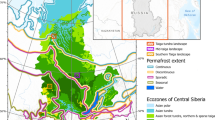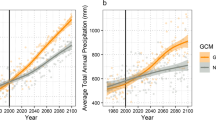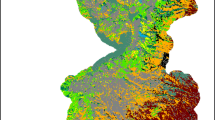Abstract
Much of the boreal forest in western North America and Alaska experiences frequent, stand-replacing wildfires. Secondary succession after fire initiates most forest stands and variations in fire characteristics can have strong effects on pathways of succession. Variations in surface fire severity that influence whether regenerating forests are dominated by coniferous or deciduous species can feedback to influence future fire behaviour because of differences in forest flammability. We used a landscape model of fire and forest dynamics to explore the effects of different scenarios of surface fire severity on subsequent forest succession and potential fire activity in interior Alaska. Model simulations indicated that high levels of surface fire severity leading to a prolonged phase of deciduous forest dominance caused a reduction in landscape flammability and fewer large fire events. Under low surface fire severity, larger patches of contiguous conifer forest promoted fire spread and resulted in landscapes with shorter fire return intervals compared to scenarios of high surface severity. Nevertheless, these negative feedbacks between fire severity, deciduous forest cover, and landscape flammability were unable to fully compensate for greater fire activity under scenarios of severe climate warming. Model simulations suggest that the effects of climate warming on fire activity in Alaska’s boreal forests may be partially but not completely mitigated by changes in fire severity that alter landscape patterns of forest composition and subsequent fire behaviour.






Similar content being viewed by others
References
Arseneault D (2001) Impact of fire behavior on postfire forest development in a homogeneous boreal landscape. Can J For Res 31:1367–1374
Balshi MS, McGuire AD, Duffy PA, Flannigan M, Walsh J, Melillo JM (2009) Assessing the response of area burned to changing climate in western boreal North America using a Multivariate Adaptive Regression Splines (MARS) approach. Glob Change Biol 15(3):578–600
Bergeron Y (2000) Species and stand dynamics in the mixed woods of Quebec’s southern boreal forest. Ecology 81(6):1500–1516
Bessie WC, Johnson EA (1995) The relative importance of fuels and weather on fire behavior in subalpine forests. Ecology 76(3):747–762
Bond-Lamberty B, Peckham SD, Ahl DE, Gower ST (2007) Fire as the dominant driver of central Canadian boreal forest carbon balance. Nature 450(7166):89–92
Brubaker LB, Higuera PE, Rupp TS, Olson M, Anderson PM, Hu FS (2009) Linking sediment-charcoal records and ecological modeling to understand causes of fire-regime change in boreal forests. Ecology 90(7):1788–1801
Calef MP, McGuire AD, Epstein HE, Rupp TS, Shugart HH (2005) Analysis of vegetation distribution in interior Alaska and sensitivity to climate change using a logistic regression approach. J Biogeogr 32:863–878
Chapin FS III, Sturm M, Serreze MC, McFadden JP, Key JR, Lloyd AH, McGuire AD, Rupp TS, Lynch AH, Schimel JP, Beringer J, Chapman WL, Epstein HE, Euskirchen ES, Hinzman L, Jia G, Ping C-L, Tape KD, Thompson CDC, Walker DA, Welker JM (2005) Role of land-surface changes in arctic summer warming. Science 310:657–660
Chapin FS III, Viereck LA, Adams P, Van Cleve K, Fastie CL, Ott RA, Mann D, Johnstone JF (2006) Successional processes in the Alaskan boreal forest. In: Chapin I FS, Oswood M, Van Cleve K, Viereck LA, Verbyla DL (eds) Alaska’s changing boreal forest. Oxford University Press, Oxford, pp 100–120
Chapin FS III, Trainor SF, Huntington O, Lovecraft AL, Zavaleta E, Natcher DC, McGuire AD, Nelson JL, Ray L, Calef M (2008) Increasing wildfire in Alaska’s boreal forest: pathways to potential solutions of a wicked problem. Bioscience 58(6):531–540
Cumming SG (2001) Forest type and wildfire in the Alberta boreal mixedwood: what do fires burn? Ecol Appl 11(1):97–110
Cumming SG, Schmiegelow FKA, Burton PJ (2000) Gap dynamics in boreal aspen stands: is the forest older than we think? Ecol Appl 10(3):744–759
Daly C, Taylor GH, Gibson WP, Parzybok TW, Johnson GL, Pasteris P (2001) High-quality spatial climate data sets for the United States and beyond. Trans Am Soc Agric Eng 43:1957–1962
Duffy PA, Walsh JE, Graham JM, Mann DH, Rupp TS (2005) Impacts of large-scale atmospheric-ocean variability on Alaskan fire season severity. Ecol Appl 15(4):1317–1330
Duffy PA, Epting J, Graham JM, Rupp TS, McGuire AD (2007) Analysis of Alaskan burn severity patterns using remotely sensed data. Int J Wildland Fire 16:277–284
Epting J, Verbyla DL, Sorbel B (2005) Evaluation of remotely sensed indices for assessing burn severity in interior Alaska using Landsat TM and ETM+. Remote Sensing Environ 96:328–339
Flannigan MD, Logan KA, Amiro BD, Skinner WR, Stocks BJ (2005) Future area burned in Canada. Clim Change 72:1–16
Greene DF, Macdonald SE, Cumming S, Swift L (2005) Seedbed variation from the interior through the edge of a large wildfire in Alberta. Can J For Res 35:1640–1647
Greene DF, Macdonald ES, Haeussler S et al (2007) The reduction of organic-layer depth by wildfire in the North American boreal forest and its effect on tree recruitment by seed. Can J For Res 37:1012–1023
Gutsell S, Johnson EA (2002) Accurately ageing trees and examining their height-growth rates: implications for interpreting forest dynamics. J Ecol 90:153–166
Hay LE, Wilby RL, Leavesley GH (2000) A comparison of delta change and downscaled GCM scenarios for three mountainous basins in the United States. J Am Water Res Assoc 36(2):387
Hély C, Bergeron Y, Flannigan MD (2000) Effects of stand composition on fire hazard in mixed-wood Canadian boreal forest. J Veg Sci 11:813–824
Higuera PE, Brubaker LB, Anderson PM, Hu FS, Brown TA (2009) Vegetation mediated the impacts of postglacial climate change on fire regimes in the south-central Brooks Range, Alaska. Ecol Monogr 79(2):201–219
Homer C, Huang C, Yang L, Wylie B, Coan M (2004) Development of a 2001 national land-cover database for the United States. Photogramm Eng Remote Sensing 70:829–840
Hoy EE, French NHF, Turetsky MR, Trigg SN, Kasischke ES (2008) Evaluating the potential of Landsat TM/ETM+ imagery for assessing fire severity in Alaskan black spruce forests. Int J Wildland Fire 17(4):500–514
Johnson EA (1992) Fire and vegetation dynamics: studies from the North American boreal forest. Cambridge University Press, Cambridge
Johnstone JF, Chapin FS III (2006a) Effects of soil burn severity on post-fire tree recruitment in boreal forests. Ecosystems 9:14–31
Johnstone JF, Chapin FS III (2006b) Fire interval effects on successional trajectory in boreal forests of Northwest Canada. Ecosystems 9:268–277
Johnstone JF, Chapin FS III, Foote J, Kemmett S, Price K, Viereck L (2004) Decadal observations of tree regeneration following fire in boreal forests. Can J For Res 34:267–273
Johnstone JF, Hollingsworth TN, Chapin FS III, Mack MC (2010) Changes in fire regime break the legacy lock on successional trajectories in Alaskan boreal forest. Glob Change Biol 16:1281–1295
Kane ES, Vogel JG (2009) Patterns of total ecosystem carbon storage with changes in soil temperature in boreal black spruce forests. Ecosystems 12:322–335
Kane ES, Kasischke ES, Valentine DW, Turetsky MR, McGuire AD (2007) Topographic influences on wildfire consumption of soil organic carbon in interior Alaska: implications for black carbon accumulation. J Geophys Res 112:G03017. doi:10.1029/2007JG000458
Kasischke ES, Turetsky MR (2006) Recent changes in the fire regime across the North American boreal region—spatial and temporal patterns of burning across Canada and Alaska. Geophys Res Lett 33(9). doi:10.1029/2006GL025677
Keeley JE, Fotheringham CJ, Baer-Keeley M (2005) Determinants of postfire recovery and succession in mediterranean-climate shrublands of California. Ecol Appl 15(5):1515–1534
Krawchuk MA, Cumming SG, Flannigan MD, Wein RW (2006) Biotic and abiotic regulation of lightning fire initiation in the mixedwood boreal forest. Ecology 87(2):458–468
Kurkowski TA, Mann DH, Rupp TS, Verbyla DL (2008) Relative importance of different secondary successional pathways in an Alaskan boreal forest. Can J For Res 38:1911–1923
Kurz WA, Apps MJ (1994) The carbon budget of Canadian forests: a sensitivity analysis of changes in disturbance regimes, growth rates, and decomposition rates. Environ Pollut 83(1–2):55–61
Payette S (1992) Fire as a controlling process in the North American boreal forest. In: Shugart HH, Leemans R, Bonan GB (eds) A systems analysis of the global boreal forest. Cambridge University Press, Cambridge, pp 144–169
R Development Core Team (2010) R: A language and environment for statistical computing, 2.4.1 edn. R Foundation for Statistical Computing, Vienna, Austria
Randerson JT, Liu H, Flanner MG, Chambers SD, Jin Y, Hess PG, Pfister G, Mack MC, Treseder KK, Welp LR, Chapin FS III, Harden JW, Goulden ML, Lyons E, Neff JC, Schuur EAG, Zender CS (2006) The impact of boreal forest fire on climate warming. Science 314:1130–1132
Rupp TS, Starfield AM, Chapin FS III (2000) A frame-based spatially explicit model of subarctic vegetation response to climatic change: comparison with a point model. Landscape Ecol 15:383–400
Rupp TS, Starfield AM, Chapin FSI, Duffy P (2002) Modeling the impact of black spruce on the fire regime of Alaskan boreal forest. Clim Change 55:213–233
Rupp TS, Chen X, Olson M (2007) Sensitivity of simulated boreal fire dynamics to uncertainties in climate drivers. Earth Interact 11(3):1–21
Skinner WR, Shabbar A, Flannigan MD, Logan K (2006) Large forest fires in Canada and the relationship to global sea surface temperatures. J Geophys Res 111:D14106. doi:10.1029/2005JD006738
Solomon S, Qin D, Manning M, Chen Z, Marquis M, Averyt KB, Tignor M, Miller HL (2007) Climate change 2007: the physical science basis: contribution of working group i to the fourth assessment report of the intergovernmental panel on climate change, 2007. Cambridge University Press, Cambridge, UK
Suffling R (1995) Can disturbance determine vegetation distribution during climate warming? A boreal test. J Biogeogr 22:501–508
Turner MG, Romme WH, Gardner RH (1999) Prefire heterogeneity, fire severity, and early postfire plant reestablishment in subalpine forests of Yellowstone National Park, Wyoming. Int J Wildland Fire 9:21–36
Van Cleve K, Viereck LA (1981) Forest succession in relation to nutrient cycling in the boreal forest of Alaska. In: West DC, Shugart HH, Botkin DB (eds) Forest succession, concepts and application. Springer-Verlag, New York, pp 184–211
Van Cleve K, Chapin FS III, Dryness CT, Viereck LA (1991) Element cycling in taiga forest: state-factor control. Bioscience 41:78–88
Walsh JE, Chapman WL, Romanovsky VE, Christensen JH, Stendel M (2008) Global climate model performance over Alaska and Greenland. J Clim 21(23):6156–6174
Yarie J (1981) Forest fire cycles and life tables: a case study from interior Alaska. Can J For Res 11:554–562
Acknowledgments
This research was supported the Bonanza Creek Long-Term Ecological Research program (funded jointly by NSF grant DEB-0620579 and USDA Forest Service, Pacific Northwest Research Station grant PNW01-JV11261952-231) and the U.S. Joint Fire Sciences Program (project 05-1-2-06). We thank Paul Duffy for his helpful comments on a previous version of this paper.
Author information
Authors and Affiliations
Corresponding author
Rights and permissions
About this article
Cite this article
Johnstone, J.F., Rupp, T.S., Olson, M. et al. Modeling impacts of fire severity on successional trajectories and future fire behavior in Alaskan boreal forests. Landscape Ecol 26, 487–500 (2011). https://doi.org/10.1007/s10980-011-9574-6
Received:
Accepted:
Published:
Issue Date:
DOI: https://doi.org/10.1007/s10980-011-9574-6




